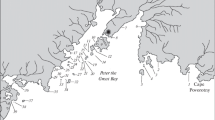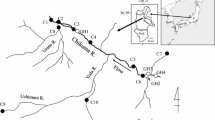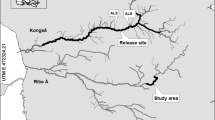Abstract
Between January 1993 and January 1995, the number of Great Cormorants (Phalacrocorax carbo) using Lake Naivasha, Kenya (00° 45′ S, 36° 20′ E) for foraging and resting increased 56%, while the number of sympatric Long-tailed Cormorants (Phalacrocorax africanus) decreased 64%. In 1995 and 1996, we documented habitat changes and conducted monthly population and resource-use surveys of the two species in an attempt to discover the most likely reasons for these changes. The increase in Great Cormorants was probably the result of immigration from nearby Lake Nakuru due to extreme water level reductions there. Lake Naivasha also experienced falling water levels and transparency during this period, but these changes were not as severe and are not considered likely reasons for the decline in Long-tailed Cormorant numbers. Despite some probable dietary overlap, the two species were well separated in terms of foraging locations, foraging methods, resting habitats and breeding timing. The decline in Long-tailed Cormorant numbers may be connected with increased disturbance by fishermen along the lake littoral, this species' primary feeding location.
Similar content being viewed by others
References
Bennun, L. A., 1992. Summary results of the 1992 January waterfowl counts. The National Museums of Kenya, Department of Ornithology, Nairobi.
Bennun, L. A. & O. Nasirwa, 2000. Trends in waterbird numbers in the southern Rift Valley of Kenya. Ostrich 71: 220–226.
Benson, C. W., R. K. Brooke, R. J., Dowsett & M. P. S Irwin, 1971. The birds of Zambia. Collins, London.
Birkhead, M. E., 1978. Some aspects of the feeding ecology of the reed cormorant and darter on Lake Kariba, Rhodesia. Ostrich 49: 1–7.
Bowmaker, A. P., 1963. Cormorant predation on two central African lakes. Ostrich March: 2–26.
Brandl, R. & H. Utschick, 1985. Size, ecology and wading birds: a nonparsimonious view. Naturwissenschaften 72: 550–552.
Brown, L. H., E. K. Urban & K. Newman (eds), 1982. The Birds of Africa, Vol. 1. Academic Press, London.
Furness, R. W. & R. T. Barrett, 1985. The food requirements and ecological relationships of a seabird community in north Norway. Ornis Scand. 16: 305–313.
Goldson, J., 1993. A three-phase environmental impact study of recent developments around Lake Naivasha. Lake Naivasha Riparian Owners Association, Naivasha, Kenya.
Harper, D. M., K. M. Mavuti & S. M. Muchiri, 1990. Ecology and management of Lake Naivasha, Kenya, in relation to climate change, alien species' introductions, and agricultural development. Environ. Cons. 17: 328–336.
Hartley, J., 1984. A guide to the Lake Naivasha area. Evans Brothers (Kenya) Ltd., Nairobi.
Johnsgard, P. A., 1993. Cormorants, Darters and Pelicans of the World. Smithsonian Institution Press, Washington, DC.
Lack, D., 1945. The ecology of closely related species with special reference to cormorant (Phalacrocorax carbo) and shag (Phalacrocorax aristotelis). Ecology 14: 12–16.
Lack, D., 1971. Ecological Isolation in Birds. Blackwell Scientific Publications, Oxford.
Linn, I. J. & K. L. I. Campbell, 1992. Interactions between white-breasted cormorants Phalacrocorax carbo (Aves: Phalacrocoracidae) and the fisheries of Lake Malawi. J. appl. Ecol. 29: 619–634.
Nasirwa, O. & L. A. Bennun, 1994. Waterbirds in the southern Kenyan Rift Valley, July 1993 and January 1994. Centre for Biodiversity Research Reports: Ornithology, No. 17: July 1994. Department of Ornithology, National Museums of Kenya, Nairobi.
Nasirwa, O. & L. A. Bennun, 1995. Monitoring of waterbirds in central Kenya, July 1994 and January 1995. Centre for Biodiversity Reports: Ornithology, No. 19: October 1995. Department of Ornithology, National Museums of Kenya, Nairobi.
Schoener, T. W., 1974 Resource partitioning in ecological communities. Science 185: 27–39.
Urban, E. K., 1992. Seasonal and opportunistic nesting of great cormorants Phalacrocorax carbo in Ethiopia. pp 475–480. Proceedings of the VIII Pan-African Ornithological Conference.
Wanink, J. H., 1996. Foraging locations of kingfishers and cormorants at Lake Victoria depend on the distribution of harvestable prey. Afr. J. Ecol. 34: 90–93.
Wiens, J. A., 1989. The Ecology of Bird Communities, Vol. 1. Foundations and Patterns. Cambridge University Press, Cambridge.
Zijlstra M. & M. R. Van Eerden, 1995. Pellet production and the use of otoliths in determining the diet of cormorants Phalacrocorax carbo sinensis: trials with captive birds. Ardea 83: 123–131.
Author information
Authors and Affiliations
Corresponding author
Rights and permissions
About this article
Cite this article
Childress, R.B., Bennun, L.A. & Harper, D.M. Population changes in sympatric Great and Long-tailed Cormorants (Phalacrocorax carbo and P. africanus): the effects of niche overlap or environmental change?. Hydrobiologia 488, 163–170 (2002). https://doi.org/10.1023/A:1023338816801
Issue Date:
DOI: https://doi.org/10.1023/A:1023338816801




